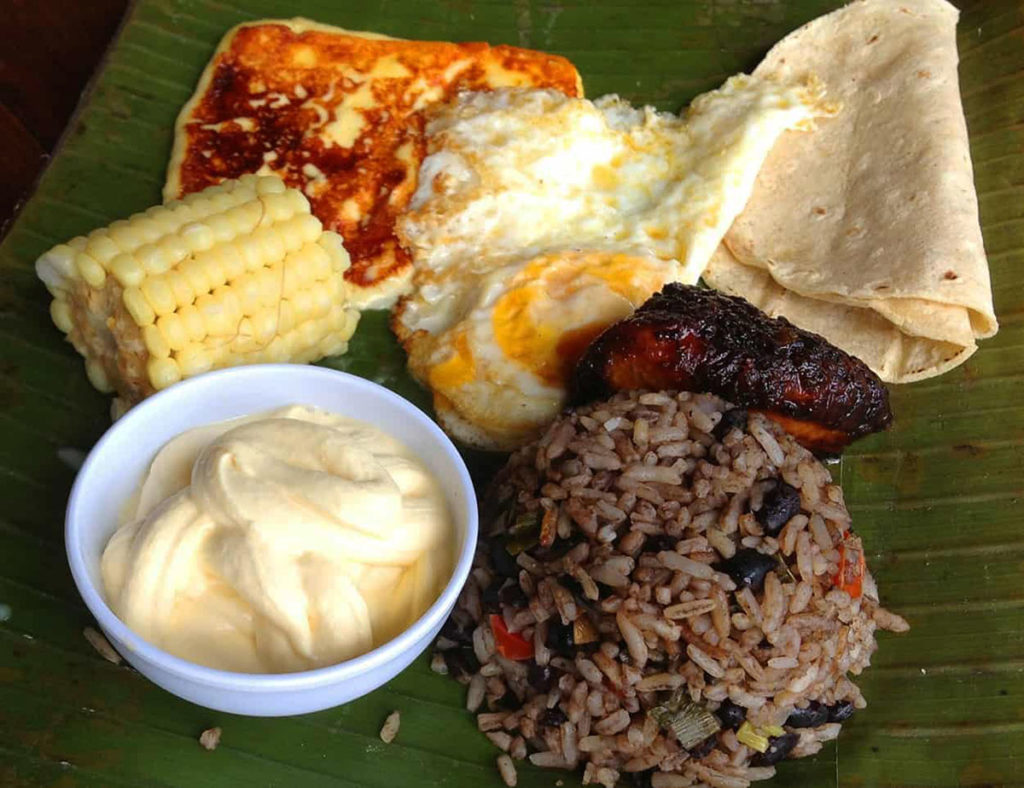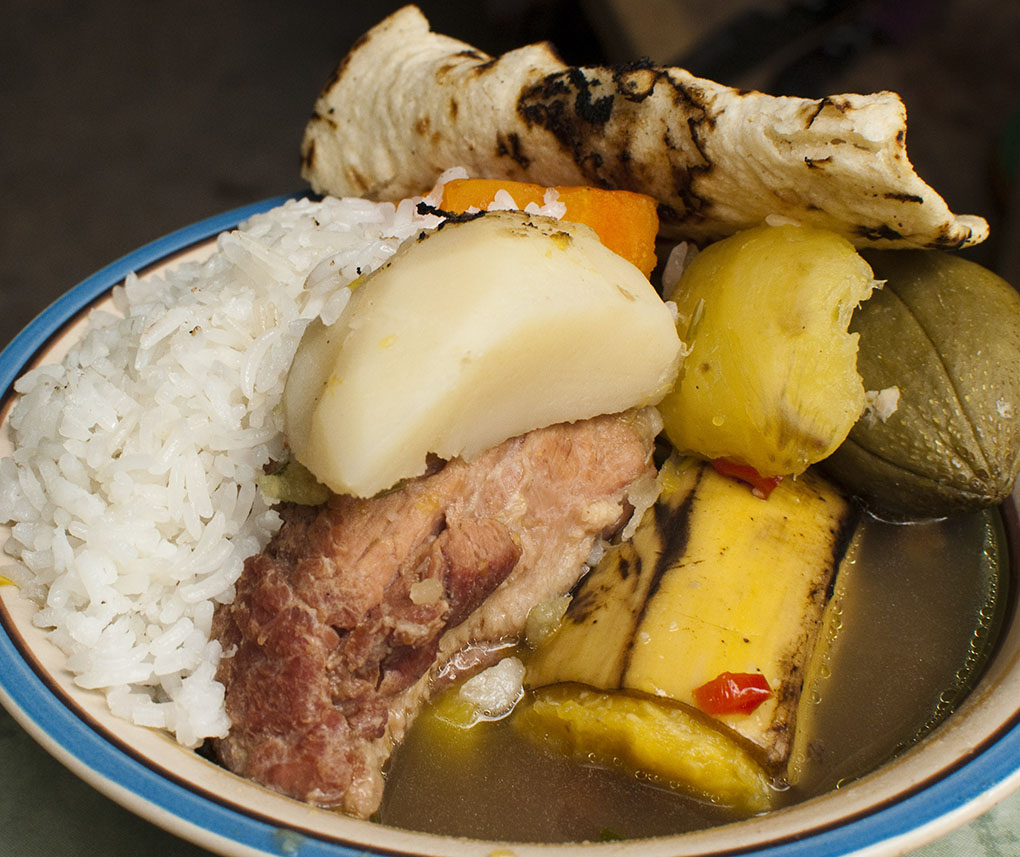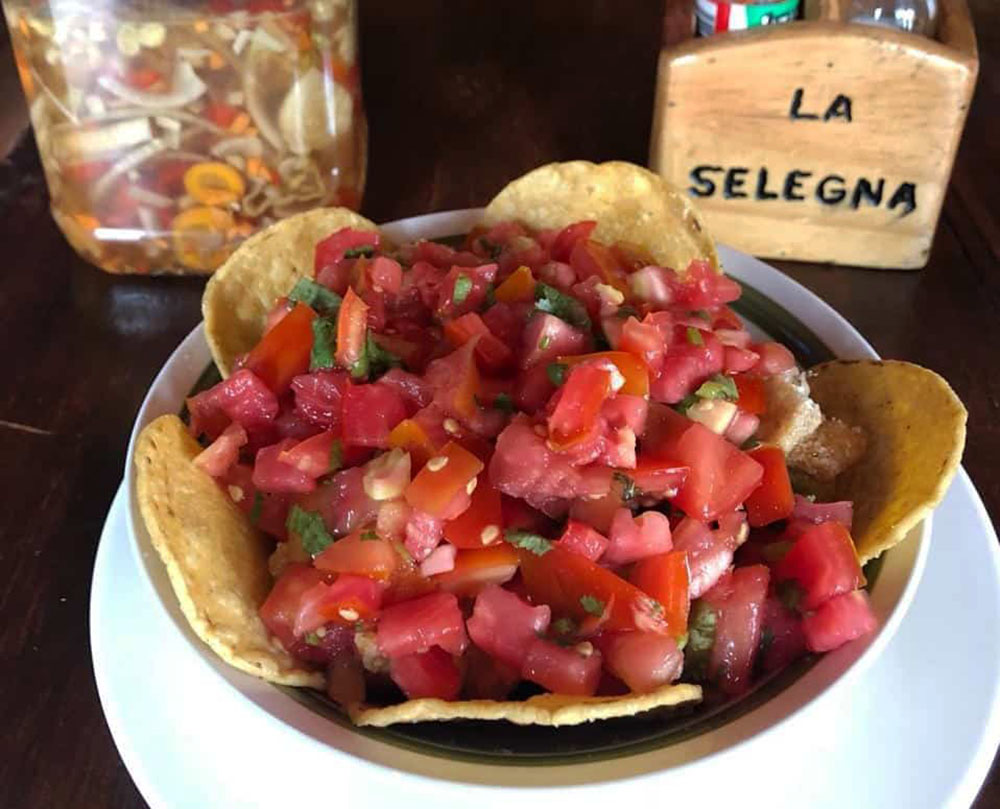
Costa Rican cuisine, often called Tico cuisine, is a vibrant reflection of the country’s rich soil, tropical climate, and cultural heritage. Unlike its spicier Central American neighbors, Tico food leans toward mild, fresh flavors, emphasizing locally grown fruits, vegetables, rice, and black beans.
These staples form the backbone of most dishes, crafted from scratch to showcase Costa Rica’s agricultural bounty. Influenced by Indigenous, Spanish, African, and Caribbean traditions, Costa Rican food is hearty, approachable, and deeply tied to community and celebration. Whether you’re a foodie or a curious traveler, these nine traditional dishes are must-tries to experience the essence of Pura Vida.
Here are 9 Traditional foods in Costa Rica you need to try
1. Gallo Pinto

Gallo Pinto, meaning “spotted rooster” in Spanish, gets its name from the speckled look of white rice mixed with black beans. This beloved dish is Costa Rica’s national breakfast, though locals enjoy it at any meal or as a side. Every Tico household has its own spin, but the core recipe involves pre-cooked rice and black beans stir-fried with onions, red bell peppers, cilantro, and a splash of Salsa Lizano, a tangy, slightly sweet condiment unique to Costa Rica.
It’s often paired with scrambled or fried eggs, fried plantains, natilla (a thin sour cream), or corn tortillas. Some Caribbean variations incorporate coconut milk for a richer flavor. A local saying, “more Tico than Gallo Pinto,” underscores its cultural significance. For authenticity, use day-old rice and beans, as they blend better when fried
2. Casado

Casado, translating to “married man,” is a hearty lunch plate symbolizing a wholesome meal a wife might prepare. The name may also reflect the “marriage” of its diverse components. A typical Casado features white rice, black or red beans, a protein (grilled chicken, fish, pork, or beef), fried plantains, a small salad, and corn tortillas.
Variations might include pic Aúnado (a vegetable hash), avocado slices, or a hard-boiled egg. Served in sodas (local diners), Casado is affordable and customizable, with sides like pasta salad or French fries occasionally appearing. Its balance of flavors and nutrients makes it a daily staple, especially in rural areas where workers need sustaining meals.
3. Arroz con Pollo
Arroz con Pollo, or chicken with rice, is Costa Rica’s take on Spanish paella, popular across Latin America. This comforting dish combines rice, shredded or diced chicken, and a sofrito base of sautéed onions, garlic, and bell peppers. Annatto or achiote lends a vibrant yellow hue, while ingredients like carrots, peas, celery, and cilantro add depth.
Some recipes incorporate beer or chicken stock for extra flavor. Unlike paella’s seafood focus, Costa Rican Arroz con Pollo is land-based, often served with a side salad, fried plantains, or tortilla chips. Each family’s recipe varies, making it a dish of personal flair, commonly enjoyed at gatherings or casual dinners.
4. Tico-style Tamale

Tamales in Costa Rica are a Christmas tradition, though available year-round in some sodas. Rooted in Aztec cuisine and spread by Spanish colonizers, Tico tamales differ from Mexican versions by using banana leaves instead of corn husks, imparting a distinct flavor.
The dough, made from corn masa, is filled with pork, chicken, or beef, plus rice, potatoes, garbanzo beans, carrots, or bell peppers. Wrapped and steamed, tamales are often served with Salsa Lizano or a mild tomato sauce. Families gather to make tamales in large batches during the holidays, a communal ritual that highlights Costa Rican warmth and togetherness.
5. Pozole

Pozole, a hearty soup of Mexican origin, has found a home in Costa Rica with slight tweaks. Traditionally made with hominy (dried corn kernels treated with alkali) and pork or chicken, Costa Rican pozole sometimes swaps hominy for garbanzo beans, creating a lighter, low-carb version.
The broth is flavored with onions, garlic, cilantro, and mild chiles, often garnished with radishes, cabbage, or lime juice. In Costa Rica, it’s a comforting meal for cooler days, especially in the Central Valley, and is typically served with corn tortillas or rice. Its adaptability makes it a favorite in both homes and restaurants.
6. Olla de Carne

Olla de Carne, or “pot of beef,” is a slow-cooked beef stew that’s a weekend favorite in Costa Rican households. Distinct from generic beef stews, it features tender beef chunks simmered with root vegetables like cassava, taro, sweet potatoes, and yuca, plus corn on the cob, carrots, and green plantains. The rich broth, seasoned with minimal spices, highlights the ingredients’ natural flavors.
Often served as a starter before a main course, Olla de Carne is a communal dish, perfect for family gatherings. Its long cooking time (four to eight hours) makes it a labor of love, especially in cooler regions.
7. Chicharrones

Chicharrones are crispy fried pork rinds, a beloved snack across Latin America. In Costa Rica, they’re typically made from pork belly or ribs, fried until golden and crunchy, then seasoned with salt and a squeeze of lime or Rangpur (a citrus hybrid).
Served at fiestas, bars, or family events, chicharrones are often paired with tortillas, pickled vegetables (chilera), or pico de gallo, a fresh salsa of tomatoes, onions, cilantro, and lime. They’re also a key ingredient in other dishes, like chifrijo. Costa Rica even hosts an annual Chicharrones Fair in Puriscal, celebrating this indulgent treat.
8. Chifrijo

Chifrijo, a relatively modern Costa Rican creation from the 1990s, is a bar snack that’s become a cultural icon. Invented by Miguel Angel Cordero Araya in a San José bar, its name blends “chicharrón” (fried pork) and “frijoles” (beans).
The dish layers white rice, cooked beans, and crispy chicharrones in a bowl, topped with pico de gallo, avocado slices, and sometimes tortilla chips or jalapeños. A drizzle of lime or chimichurri adds zest. Best enjoyed with a cold beer, chifrijo is a staple in San José’s cantinas and sodas, offering a perfect balance of savory, fresh, and crunchy textures.
9. Sopa Negra
Sopa Negra, or black bean soup, is a soul-warming dish that showcases Costa Rica’s love for black beans. The dark, velvety broth comes from simmering black beans with onions, garlic, bell peppers, and cilantro, often spiked with a dash of Tabasco for mild heat.
A unique touch is the inclusion of whole or chopped hard-boiled eggs cooked directly in the soup, adding heartiness. Served with rice, corn tortillas, or avocado, Sopa Negra is a go-to comfort food, especially in chilly areas like the cloud forests. It’s also vegetarian-friendly, making it versatile for diverse diets.
Comparison of Traditional Costa Rican Dishes
To help you choose which dishes to try, here’s a table summarizing key details about each food, including meal type, main ingredients, and typical serving occasions.
| Dish | Meal Type | Main Ingredients | Typical Occasion |
|---|---|---|---|
| Gallo Pinto | Breakfast/Side | Rice, black beans, onions, bell peppers, cilantro, Salsa Lizano | Daily breakfast, any meal |
| Casado | Lunch/Dinner | Rice, beans, protein (chicken, fish, pork, beef), plantains, salad, tortillas | Daily lunch, casual dining |
| Arroz con Pollo | Lunch/Dinner | Rice, chicken, onions, garlic, bell peppers, annatto, carrots, peas | Family gatherings, casual meals |
| Tico-Style Tamale | Snack/Specialty | Corn masa, pork/chicken, rice, potatoes, garbanzo beans, banana leaves | Christmas, holidays |
| Pozole | Lunch/Dinner | Hominy or garbanzo beans, pork/chicken, onions, garlic, cilantro, chiles | Cooler days, family meals |
| Olla de Carne | Dinner/Starter | Beef, cassava, taro, sweet potatoes, corn, carrots, plantains | Weekend family meals |
| Chicharrones | Snack | Fried pork rinds, lime, salt, optional pico de gallo or tortillas | Fiestas, bars, casual snacking |
| Chifrijo | Snack/Appetizer | Rice, beans, chicharrones, pico de gallo, avocado, tortilla chips | Bar food, casual gatherings |
| Sopa Negra | Lunch/Dinner | Black beans, onions, garlic, bell peppers, cilantro, hard-boiled eggs, tortillas | Chilly days, comfort meals |
Final Thoughts
Costa Rican cuisine is more than just food—it’s a celebration of community, heritage, and the land’s abundance. From the morning ritual of Gallo Pinto to the festive tamales of Christmas, each dish tells a story of cultural fusion, blending Indigenous, Spanish, African, and Caribbean influences. Whether you’re dining in a bustling soda or a family kitchen, Tico food invites you to savor fresh, simple ingredients and the warmth of Pura Vida.
For travelers, exploring these dishes offers a delicious way to connect with Costa Rica’s vibrant culture. Pair your meal with a cup of world-class Costa Rican coffee, brewed traditionally via a chorreador, and you’ll understand why food is at the heart of Tico life.

